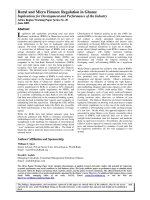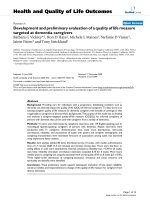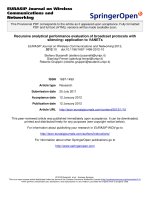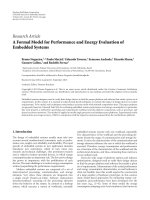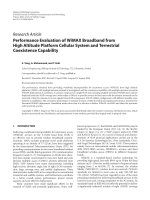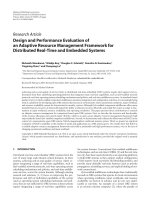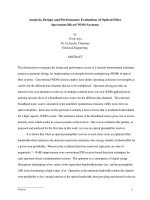Development and performance evaluation of tractor drawn turmeric digger cum separator
Bạn đang xem bản rút gọn của tài liệu. Xem và tải ngay bản đầy đủ của tài liệu tại đây (528.91 KB, 9 trang )
Int.J.Curr.Microbiol.App.Sci (2019) 8(2): 1053-1061
International Journal of Current Microbiology and Applied Sciences
ISSN: 2319-7706 Volume 8 Number 02 (2019)
Journal homepage:
Original Research Article
/>
Development and Performance Evaluation of Tractor Drawn
Turmeric Digger cum Separator
Shailaja Deshvena*, R.T. Ramteke and S.N. Solanki
Department of Farm Machinery & Power Engineering, College of Agricultural Engineering,
Parbhani, V.N.M.K.V. Parbhani. (Maharashtra State), India
*Corresponding author
ABSTRACT
Keywords
Performance,
Tractor, Digger cum
Separator, Field
capacity
Article Info
Accepted:
10 January 2019
Available Online:
10 February 2019
The tractor drawn turmeric digger cum separator was developed with an objective to have
mechanical means for harvesting of turmeric crop. The components were designed and
developed keeping in view of objective crop, soil and machine parameters. The machine
consisted of a main frame, digging blade, depth gauge wheel, power transmission system,
and conveying mechanism. The performance evaluation of developed machine was
evaluated at Khanapur village Parbhani district of Maharashtra State. The experiment was
undertaken in black cotton soil; the range of observed moisture content was 12.23 to 16.28
percent moisture content (db) at the time of harvesting. The size of the experiment plot
was 0.5 ha was taken for observations. During field testing of machines, draft, digging
efficiency, per cent damage of turmeric rhizome and fuel consumption, separation index
and power requirement were calculated. The field capacity was also measured. The
turmeric digger cum separator was tested at three different shapes of digging blades and at
three different levels of forward speed i.e. 1.5, 3.0 and 4.5 km h -1. The draft and power
requirement for harvesting turmeric digger cum separator was found to be draft 2199 N
and Power requirement 0.91 kW respectively. Fuel consumption for particular operation
was observed to be 6.12 l h-1.The field capacity of turmeric digger cum separator was
calculated 0.47 ha h-1. The digging efficiency, damage of rhizome and separation index of
turmeric digger cum separator was recorded to be 97.35 ha hr 3.34 per cent and 0.24 per
cent.
Introduction
Turmeric is also called as “The Golden Spice
"and “Indian Saffron” (Devi and Sangamithra,
2011). Turmeric botanically known as
Curcuma longa L. (Syn. Curcuma domestica)
belongs to the family Zingiberaceae is one of
the most important and ancient spices of India
and a traditional item of export, which is used
daily. Botanist, Valeton coined the name
Curcuma domestica (Anon., 2007). The word
Curcuma, is derived from the Arabic
“kurkum” and from the Hebrew “karkom”
which means “yellow”. The term longa refers
to the elongated shape of its rhizome. It
contains appreciable quantities of proteins
(8.6%), fats (8.9%), mineral matters (6.8%)
carbohydrates (63.0%), Vitamin A (175
1053
Int.J.Curr.Microbiol.App.Sci (2019) 8(2): 1053-1061
IU/100g), Sodium (0.01%), Potassium (2.5%)
and fibre (6.9%) (Parthasarathy and
Kandiannan, 2007).
Apart from nutritional advantages the demand
of turmeric is due to its property of colouring
and flavouring of cooked stuff. These sensory
properties of turmeric are due to the presence
of curcumin and essential oil which is
generally present in the turmeric rhizome.
India is the largest producer, consumer and
exporter of turmeric in the world. Indian
turmeric is considered the best in the world
market because of its high curcumin content
(Devi and Sangamithra, 2011) India
dominates the world production scenario
contributing 78 % followed by China (8%),
Myanmar (4%) and Nigeria and Bangala
Desh together contributing to 6% of the
global production. India is the global leader in
value added products of turmeric and
exports.).
The main turmeric producing states in India
are Telangana, Andhra Pradesh, Tamilnadu,
Maharashtra, Orissa, West Bengal, Karnataka,
Kerala. In the year 2017-18 Maximum area
under turmeric cultivation is in Telangana
(50.00 thousand ha), where production is very
high i.e. 294.00 thousand tones. Then comes
Maharashtra, Tamilnadu, Orissa and West
Bengal, Assam, Mizoram. In case of
production major share is taken by Andhra
Pradesh accounted to 31.11% of total turmeric
production in India, followed by Tamilnadu.
In Tamilnadu, turmeric is cultivated in about
67246 ha with production of about 368411
tons with average productivity of 5.48 t/ha.
Kadte (2017) studied on economics of
turmeric production in Maharashtra and
concluded that Turmeric production in India
has shown a fluctuating trend in last five
years. It was 43000 tones in 2011-12, and
increased to 65000 tones in 2012-13. Again
decreased to 37000 tones in 2013-14 and then
increased to 70000 tones in 2014-15. The
annual turmeric production was 48500 tones
in 2015-16. Hence price of turmeric is not
fixed and tend to fluctuate year by year.
Maharashtra state in India ranks sixth
in area under turmeric cultivation. The area
under crop was 11000 hectare with a
production of 45000 tones and productivity of
4.09 tonnes/hectare during 2015-16. In
Maharashtra Sangali, Satara, Hingoli,
Nanded, Parbhani are the major turmeric
growing districts. It is one of the major crop
in Sangali district. In Sangali the area under
turmeric is 1500 hectares, whereas production
and productivity is 13000 tonnes and 8.6
tonnes /hectare, respectively in 2015-16.
Harvesting is one of main important operation
in turmeric cultivation. In India, it is
performed by manual method with the help of
hand tools i.e., special fork type of spade/
pick axe, bullock drawn and power operated
devices and by using traditional diggers
drawn by tractors or power tillers. It was
found that there is a noticeable damage to the
crop during harvesting. However, most of the
digging operation during turmeric harvesting
is done manually due to non availability of
suitable devices.
The post harvest studies of turmeric indicated
that, about 70 per cent of the rhizomes are
spoiled and wasted due to the storage rots
caused by rough harvesting and handling
practices resulting in injury of skin and flesh
of the rhizomes (Rattan et al., 1988).
Sometimes, bullock operated wooden plough
is also used for tuber crop harvesting. These
conventional methods need more labour with
less field capacity which increases cost of
operation. On an average, about 600 man-h of
labour per hectare is required for harvesting
of root crops manually (Sharma and Varma
1986). This method of harvesting is highly
labour intensive, tedious and time consuming.
1054
Int.J.Curr.Microbiol.App.Sci (2019) 8(2): 1053-1061
It is also a very difficult task on the part of
farmer to get required labour force during the
harvesting season for the timely harvesting of
crop. To alleviate all this, there is a need to
develop a suitable mechanical harvesting
technology for turmeric crops. The
mechanization of turmeric harvesting is need
of the hour as it saves harvesting time, cost of
harvesting, crop damage and reduce drudgery
involved. Keeping in view of the above points
in mind, the present study was undertaken
with the objective of development and
performance evaluation of tractor drawn
turmeric digger cum separator.
Materials and Methods
Designed and developed a turmeric digger
cum separator for harvesting turmeric crop by
considering soil, biometric and machine
parameters utilizing PTO power of the tractor.
The main purpose was to design the machine
for harvesting turmeric crop with minimum
draft
requirement,
maximum
digging
efficiency, low damage to rhizome and less
fuel consumption along with greater soil
separation at economic cost of operation. The
fabricated machine consisted of main frame,
gear box housing, power transmission system,
depth gauge wheel, digging unit, ground
wheel, elevator conveyor system. The
machine consisted of a main frame having
dimensions 1610 x 1140 mm for mounting
digging blade, vibration unit, power
transmission system depth gauge wheel and
elevator conveyor systems. Digger blade
having length, width and thickness of 1140 x
380 x 08 mm respectively. The blade was
mounted at an angle of 20 degree with the
horizontal. Two depth gauge wheels having
diameter of 450 mm were mounted at both
sides of the blade with the spacing between
two wheels being 1200 mm. A flat strip was
provided immediately after the digging blade
for stepping up of soil from the dug crop in
the system.
Results and Discussion
The power transmission system has been
made at two stages, first from PTO to
machine gear box from which power is
transmitted to the conveyor by a belt
mechanism system. A machine support over
the ground wheel made of pneumatic wheel
was provided at centre both sides of the
digger machine. The diameter and width of
the wheel are 320 and 100 mm respectively.
An elevator conveyor was attached behind the
digging unit. The soil-rhizome separating unit
consisted of conveyor having dimensions of
1500 x 1080 mm. The conveyor unit
consisted of MS rods spaced at 30 mm. The
angle of the elevator was kept at 20 degree to
the conveying system for separation of soil
particles from the rhizome and windrowing in
one row at the rear of the machine. The power
to the elevator conveyor was provided
through a gear box by belt and pulley drive
system.
Experiments were conducted according to the
plan of the experiment indicated in Table 2.
For each test, Matured crop was harvested
using experimental set-up of tractor drawn
turmeric digger cum separator. The
observations on performance parameters were
recorded for each test run. All the test runs
were replicated thrice to eliminate any
experimental bias.
The experiments on test set-up were planned
by changing blade type (Strips shape, Inverted
V shape and Crescent shape), rake angle (15°,
20° and 25°) and speed of operation (1.5, 3.0
and 4.5 km h-1) and these independent
variables were tested with dependent
variables like: draft, digging percentage, per
cent damage of rhizome, soil separation index
and power requirement. The moisture content
of the soil was changed (12.23 ± 0.18, 14.23 ±
0.35 and 16.28 ± 0.38 %) at desired level and
depth of operation was also optimized based
1055
Int.J.Curr.Microbiol.App.Sci (2019) 8(2): 1053-1061
on biometric properties. Soil bulk density was
also measured randomly at five different
places.
All the experiments were conducted for each
one bed lengths which having two rows of
turmeric crop for every replication according
to the plan of experiments. The first test of
experiment was carried out at soil moisture
content 16.28±0.38 per cent with strips shape
blade kept rake angle at 15 degree and the
data was recorded at three different speeds of
operation. Similarly, tests were conducted for
rake angle of 20 and 25 degree and all
performance observations were recorded.
Each test run was replicated thrice.
Similar set of experiments was carried out
using inverted V blade and crescent blade.
Thus a total number of 243 runs were
completed and performance data was
recorded.
Data were recorded for weight of turmeric
rhizomes harvested, weight of turmeric
rhizomes not harvested, wt of turmeric
rhizomes damaged and weight of soil
collected with turmeric rhizomes mass for a
test length of 10 m. From this test data, the
following performance parameters were
determined to evaluate the machine.
Results and Discussion
Performance evaluation of the developed
tractor drawn turmeric digger cum separator
was carried out in an experimental field of
Khanapur village Parbhani district of
Maharashtra State. during 2016-17-18.
Results of the experiments on turmeric digger
and separator units were the basis for
selection of design values of the prototype of
tractor drawn turmeric digger cum separator
as detailed mentioned, a strips shape blade
with rake angle of 20 degree and 3.0 km h-1 as
selected. Keeping in view of draft, digging
efficiency, per cent damage of rhizome, soil
separation index and power requirement of
the digger machine. Keeping in view the best
performance of machine in terms of soil
separation index and power requirement. The
speed ratio of 1.0 to 1.5 the prototype was
kept at 1.25.The overall performance of this
mechanism was better in respect of draft,
digging efficiency, per cent damage of
rhizome, fuel consumption, soil separation
index and power requirement.
Testing of the turmeric digger was done
according to the BIS code 11235, 1981 and
BIS code 13818, 1993 by following the Test
Code and procedure as per Regional Network
For Agriculture Machinery, Philippines
(RNAM 1983) test procedure for root crop
digger elevator (Table 1). The following
design
and
operational
parameters
recommended for the final prototype of
turmeric digger cum separator are given in
The turmeric digger cum separator was
evaluated under optimized parameters viz.,
strips shape blade, soil moisture content
14.23±0.35 per cent, 20 degree rake angle and
3.0 km h-1 forward speed. The prototype
turmeric digger cum separator was evaluated
for 0.5 ha.
The performance parameters and viz., depth
of operation, width of operation, speed of
operation, draft, digging efficiency, per cent
damage of rhizome, fuel consumption,
separation index and field capacity were also
recorded and presented in Table 4.
It is concluded that in the present study, a
tractor drawn turmeric digger cum separator
was designed and developed. The developed
prototype was tested and the best optimal
solution (Table 3) of digging unit was
selected strips shape digging blade at three
different levels of a forward speed of 1.5, 3.0
and 4.5 km h-1.
1056
Int.J.Curr.Microbiol.App.Sci (2019) 8(2): 1053-1061
Table.1 The detailed specifications of the turmeric digger cum separator
Sr.no
Component
1.
Digger blade
a) Length, mm
380
b) Width, mm
1140
c) Thickness, mm
08
Separating unit
a) Length, mm
3000
b) Width, mm
1080
c) Canvas belt strip width, mm
65
d) Diameter of rod, mm
12
e) Spacing between rods, mm
25
f) Number of rods
70
g) Height of conveyor from ground, 39 front
50 rear
mm
Power transmission system
i. Number of flanges in the coupling
2
ii. Diameter of the input to the gear
30
box, mm
iii. Length of the input shaft to the
480
gear box, mm
iv. Gear reduction in gear box
1:2
v. Diameter of the output shaft from
35
the gear box, mm
vi. Length of the output shaft from
1500
the gear box, mm
vii. Speed reduction by the belt 3:1
pulley
viii. Center to center distance
1420
between pulley, mm
ix. Number teeth of idler
10
Main frame
a) Length, mm
1610
b) Width, mm
1140
c) Height, mm
600
Overall dimensions
a) Length, mm
2000
b) Width, mm
1480
c) Height, mm
1180
Weight of the digger machine, kg
490
2.
3.
4.
5.
6.
Dimens
ions
1057
Int.J.Curr.Microbiol.App.Sci (2019) 8(2): 1053-1061
Table.2 Variables selected for the test of turmeric digger cum separator
Sr.No
1
Parameters
Independent
Levels
1. Soil parameter
Moisture Content (%)
2. Machine parameter
Rake angle, degree
3. Tractor parameter
Forward Speed (km.h-1)
4.Shape of digging blade
12, 14, 16
15o, 20o, 25o
1.5, 3.0, 4.5
1.Strips shape
2.Inverted'V'shape
3.Crescent shape
Performance parameters to
be measured Dependent
Bulk density of soil was
measured at respective soil
moisture content.
1. Harvesting percentage
2. Soil separation index
3. Damage percentage
4.Power requirement(kW)
5.Draft of machine.
Constant parameters
i) Length of blade, mm
ii) Length of soil separator, mm
Total number of treatment combinations = 3 x 3 x 3 x 3 = 81
Number of replications = 3
Total number of runs of experiments = 81×3 = 243
2
Table.3 Best optimal solution of digging unit
Sr.no
Variables
Optimal Values
1
2
3
4
Tool geometry
Optimum soil moisture content
Rake angle
speed of operation
Strips shape digging blade
14.23±0.35 per cent
20°
3.0 km h-1
Table.4 Performance values of final recommended Strips shape digging blade for turmeric
digger machine
Sr.no.
1
Performance parameters
Digging efficiency, per cent
Performance value Range
97.35
2
Soil Separation index, per cent
0.24
3
Turmeric rhizome damage, per cent
3.34
4
Depth of cut in mm
215
5
Fuel consumption, l/h
6.12
6
Draft, N
2199
7
Field capacity, ha/h
0.47
8
Power requirement, kW
0.91-3.68
1058
Int.J.Curr.Microbiol.App.Sci (2019) 8(2): 1053-1061
Plate no. 1 Different shape of blades
Plate no. 2 Field evaluation of Turmeric digger
Plate no. 3 Field testing of developed turmeric digger cum separator
1059
Int.J.Curr.Microbiol.App.Sci (2019) 8(2): 1053-1061
Top view of turmeric digger machine
Sr.no.
Particulars
1
Three point linkage
2
Main frame
3
Gear Box
4
Digging blade
5
Conveyor bars
6
Power transmission system
7
Transport wheel
8
Gauge wheel
9
Canvas belt
10
Star wheel
11
Reduction pulley
12
Input shaft
13
Output shaft
Isometric view of turmeric digger cum separator
The draft and power requirement for
harvesting turmeric crop using digger cum
separator was measured and it was found to
be 2199 N and 0.91 kW respectively. Fuel
consumption for particular operation was
observed to be 6.12 l h-1. turmeric digger cum
separator was calculated respectively. The
field capacity was to be found 0.47 ha h-1
respectively.
The performance of the final developed
turmeric digger cum separator was recorded
to be digging efficiency 97.35 per cent,
Damage percentage 3.34 per cent, Soil
separation Index 0.24 per cent, fuel
consumption 6.12 l/h, draft 2199 N and Power
requirement 0.91 kW.
References
Anonymous, 2007. Significance of turmeric
as spice in India. Dolcas Biotech LLC,
pp 1-11.
Devi, K. S. P. and Sangamithra, A. (2011).
1060
Int.J.Curr.Microbiol.App.Sci (2019) 8(2): 1053-1061
Turmeric - Indian Saffron, Technical
Kadte, A.J., D.S. Perke and P. S. Kale (2018)
Economics of Turmeric Production in
Sangli District of Maharashtra, India.
Int.J.Curr.Microbiol.App.Sci
(2018)
Special Issue-6: 2279- 2284 Bulletin:
Science Tech Entrepreneur. pp. 1-7.
Kawale Nagendra et al., (2018) Development
and Evaluation of Tractor Drawn
Ginger Harvester cum Elevator
International Journal of Current
Microbiology and Applied Sciences
Volume 7 Number 12
Parthasarathy, V. A. and Kandiannan, K.
(2007). Spices and Condiments, IISR,
Calicut.
Rattan, R. S., Korla, B. N. and Dohroo, N. P.,
(1988), Performance of ginger varieties
under Solan conditions of Himachal
Pradesh. Proceedings of National
Seminar on Chillies, Ginger and
Turmeric., pp 71-73.
Sharma, A. P. and Verma, S. R., 1986,
Design,
development
and
field
evaluation of an oscillatory potato
digger. AMA., 17(3): 60-62.
How to cite this article:
Shailaja Deshvena, R.T. Ramteke and Solanki, S.N. 2019. Development and Performance
Evaluation of Tractor Drawn Turmeric Digger cum Separator. Int.J.Curr.Microbiol.App.Sci.
8(02): 1053-1061. doi: />
1061
